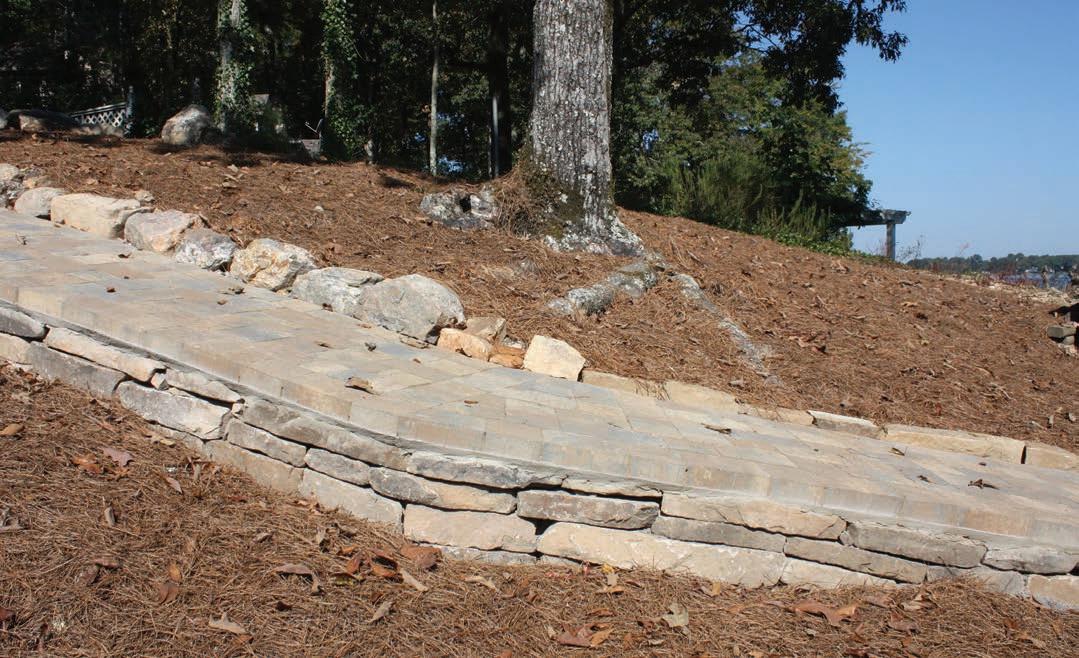
6 minute read
SKILL SET
By Matt Weber To give a wood deck the best pro-
tection and to keep it looking good, you should maintain it with a quality
stain/sealer. Here are some tried-and-true stain application tips we’ve learned over the years.
DRY IT FIRST
For newly constructed decks, it’s a good idea to let the wood weather before staining. For decks built with treated lumber, the waterborne preservative leaves moisture in the wood. This is why fresh PT lumber often arrives wet from the supplier, and the moisture can block penetration of stains and paints. For best performance of stain coatings, most stain/sealers recommend that treated wood dry 4 to 8 weeks prior to application after the decking is installed. Drying time depends on how much time has elapsed since chemical treatment, the wood’s exposure to the sun, ambient weather and temperature.
For decks built with exotic hardwood, the dense wood needs time to weather because the natural oils can block stain from penetrating. After construction, let the sun, wind and rain break down the surface of the wood, so the oils dry out and the stain will be more easily absorbed. The more the wood weathers, the easier it will be to stain the hardwood.


s One a recent deck-sealing project, we used ZAR Deck & Siding Stain from UGL. This solid color stain/sealer is formulated with 100-percent acrylic resins and a unqiue alkyd blend for a long-lasting coating that shields against sun, rain, snow and even salt air.
There are a few exceptions to this general rule. New EPA-registered stain/sealers that meet the industry’s latest end-cut warranty requirements can successfully stain the entire deck during or immediately after construction. Check the product labels (and see sidebar on page 34).
KEEP IT CLEAN
All wood needs to be cleaned well before staining. It should be obvious that dirt or mud should be cleaned off before application, but brand new lumber should be cleaned to remove “mill scale” (crushed wood grain that occurs during the milling process and can prevent stain penetration).
For the best-looking finish on an older deck, graying from the sun, mildew and old stains all need to be removed prior to staining. Oxygenated bleaches are highly effective at cleaning the wood, plus they won’t harm surrounding plant life and vegetation. Rinse off the bleach thoroughly.
STRIP AND BRIGHTEN?
For previously stained decks, stain strippers can help prep the surface. Formulated using sodium hydroxide, these chemical strippers can be effective at breaking down the surface
of the wood, opening its pores to make it more absorbent. If using a stripper, it’s also a good idea to use a wood brightener. A wood brightener will neutralize the effects of the stripper and, similar to the stripper, the brightener will help to open the porosity of the wood even further for the best stain penetration. Again, rinse thoroughly and give the deck time to completely dry for at least a day before staining.
PROJECT TIMING
Try to avoid applying stain in direct sunlight. The heated wood and sun both tend to dry the stain/sealer nearly as quickly as you apply the product, which can impede finish quality, and possibly reduce absorption into the wood. On the other hand, you should also avoid staining within 24 hours of rain, so staining on an over-cast day can be risky. Keep an eye on the forecast and use your best judgment. Morning and evening hours often make better application times than high noon.
TYPE OF STAIN
Traditionally, oil-based deck stain/sealers have been considered the go-to choice for a long-lasting penetrating finish. However, water-based stains have made great strides in performance and can offer some real advantages--namely, they clean up with soap and water, and there are no harsh solvents to breathe. Research your product and check its warranty.
TRY TO AVOID APPLYING STAIN IN DIRECT SUNLIGHT.


s s
Working from the top down, I begin application to the guardrail using a stain pad. The ZAR solid stain has a thick, paint-like workability, plus it cleans up with water. For knots and checks in the wood, I use a paint brush to work the product deep into the wood grain for the best protection.
s I use a stain mitt to apply product to the spindles of the rail system. This method does a good job of spreading the sealer around all sides of the narrow boards, but I still had to follow up with a brush and/or stain pad to ensure even coverage. Make sure to wipe up drips and runs.
Semi-transparent stains will allow the natural wood grain and color variation to show through the finish. Solid stains will give an opaque finish to the wood, which conceals the woodgrain but retains its texture. The choice is your, but make sure you understand the difference.

READ THE CONTAINER
Everything that you need to know about your product is on the back of the can. Take a few minutes to read it before you begin. Not all products are meant to be applied the same way. What is the drying time? How many coats should you apply? How much time between coats? Is there a critical re-coat time?
BRUSHING IS CRITICAL
You have options for application: brushes, rollers, sprayers, stain pads, etc. Regardless


s I like to "cut in" the edges of a deck surface just like on a painting project to keep the stain brush away from siding ad trim. Here, I'm using a paint shield as a moveable masking tool. The best practice is to brush in the stain/sealer product to achieve the longest-lasting finish, and the Deck Boss from Perdura Brushes is the best tool I've found for the job. The thick bed of bristles retains plenty of product, the stiff bristles push sealer into the woodgrain, and the broad head spans both edges of a 1x6 deck board.

s


of how you apply the stain, it is very important to brush the product into the wood grain. If you roll it on first, then back-brush it into the grain while it is still wet. The same applies for spraying. When you brush the stain, the brush creates a friction that breaks the surface tension of the wood and works the stain into the pores. This step achieves much better penetration of the stain. The more stain/sealer the wood absorbs, the longer the project will last before requiring maintenance coats.
WIPE OFF EXCESS
If you apply more stain than the wood can absorb, then wipe off the excess. When you apply too much stain, it puddles on the surface and looks bad because of the uneven tone. Furthermore, those spots are likely to flake and peel over time. Apply only as much stain as the wood can easily absorb. H
s The ZAR solid-color stain does a fine job concealing discolorations in the deck surface.

Here's the newly stained deck featuring the stain/sealer in a chocolate solid color tone.









